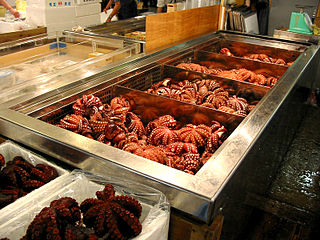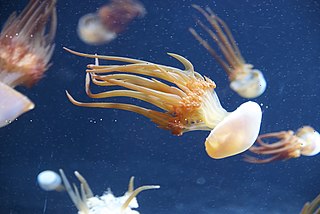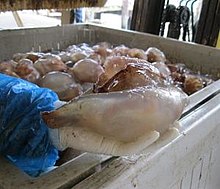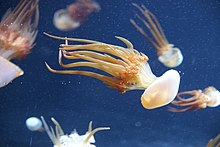
Nori(海苔) is a dried edible seaweed used in Japanese cuisine, made from species of the red algae genus Pyropia, including P. yezoensis and P. tenera. It has a strong and distinctive flavor, and is often used to wrap rolls of sushi or onigiri.

Brazilian cuisine is the set of cooking practices and traditions of Brazil, and is characterized by European, Amerindian, African, and Asian influences. It varies greatly by region, reflecting the country's mix of native and immigrant populations, and its continental size as well. This has created a national cuisine marked by the preservation of regional differences.

Roe or hard roe is the fully ripe internal egg masses in the ovaries, or the released external egg masses, of fish and certain marine animals such as shrimp, scallop, sea urchins and squid. As a seafood, roe is used both as a cooked ingredient in many dishes, and as a raw ingredient for delicacies such as caviar.

Leaf vegetables, also called leafy greens, pot herbs, vegetable greens, or simply greens, are plant leaves eaten as a vegetable, sometimes accompanied by tender petioles and shoots. Leaf vegetables eaten raw in a salad can be called salad greens.

Nomura's jellyfish is a very large rhizostome jellyfish, in the same size class as the lion's mane jellyfish, the largest cnidarian in the world. It is edible but not considered high quality. It is the only species in the monotypic genus Nemopilema.

Takuan, or takuan-zuke, known as danmuji (단무지) in the context of Korean cuisine, is a pickled preparation of daikon radish. As a popular part of traditional Japanese cuisine, takuan is often served uncooked alongside other types of tsukemono. It is also enjoyed at the end of meals to aid digestion.

Dried shrimp are shrimp that have been sun-dried and shrunk to a thumbnail size. They are used in many East Asian, Southeast Asian and South Asian cuisines, imparting a unique umami taste. A handful of shrimp is generally used for dishes. The flavors of this ingredient are released when allowed to simmer.

The cannonball jellyfish, also known as the cabbagehead jellyfish, is a species of jellyfish in the family Stomolophidae. Its common name derives from its similarity to a cannonball in shape and size. Its dome-shaped bell can reach 25 cm (10 in) in diameter. The rim is often colored with brown pigment. There are several known undescribed Stomolophus species found in the Pacific and South Atlantic that exhibit pale to blue pigment. They are genetically different from the individuals found in the North Atlantic - but are commonly misidentified as such. Underneath the body is a cluster of oral arms that extend out around the mouth. These arms function in propulsion and as an aid in catching prey. Cannonballs are prominent from North America's eastern seaboard to the Gulf of Mexico.

Bamboo shoots or bamboo sprouts are the edible shoots of many bamboo species including Bambusa vulgaris and Phyllostachys edulis. They are used as vegetables in numerous Asian dishes and broths. They are sold in various processed shapes and are available in fresh, dried, and canned versions.

People of some cultures eat octopus. The arms and sometimes other body parts are prepared in various ways, often varying by species and/or geography.

This is a categorically-organized list of foods. Food is any substance consumed to provide nutritional support for the body. It is produced either by plants, animals, or fungi, and contains essential nutrients, such as carbohydrates, fats, proteins, vitamins, or minerals. The substance is ingested by an organism and assimilated by the organism's cells in an effort to produce energy, maintain life, or stimulate growth.

Rhopilema esculentum, the flame jellyfish, is a species of jellyfish native to the warm temperate waters of the Pacific Ocean. It is a popular seafood in southeastern Asia. In the 1980s, research was undertaken in China into its aquaculture, and it is now bred in ponds in that country before being released into the sea to grow to a mature size suitable for the fishery.

Chahan, also known as Yakimeshi, is a Japanese fried rice dish prepared with rice as a primary ingredient and myriad additional ingredients and seasonings. The dish is typically fried, and can be cooked in a wok. Chahan may have originated in the 1860s from Chinese immigrants arriving at the port of Kobe. Chahan is a staple food in homes in Japan. A variation of the dish is takana chahan. Some restaurants outside Japan serve the dish as a part of their fare.






















